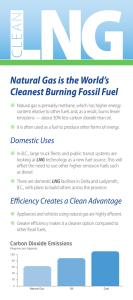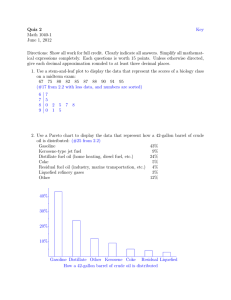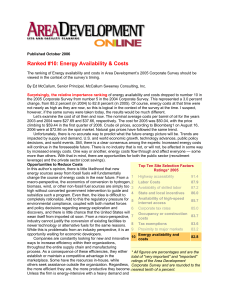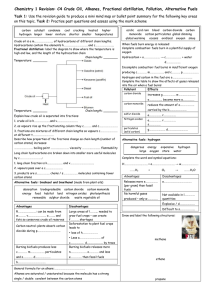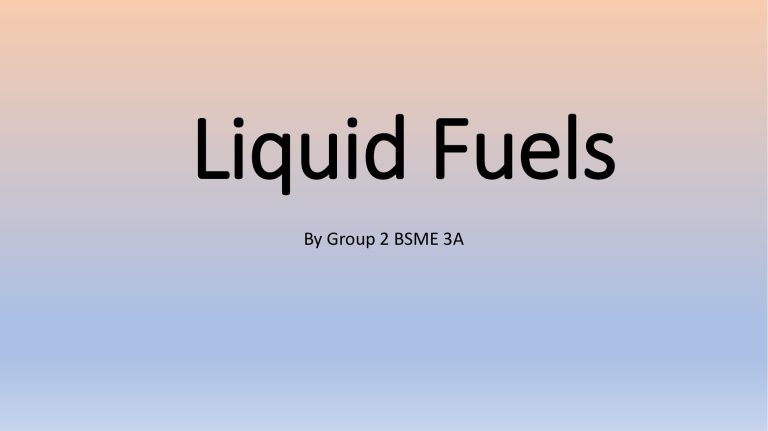
Liquid Fuels By Group 2 BSME 3A What is Fuel? Any substance used to produce energy called Fuel. Any combustible substance which may be burnt to supply heat for practical application without the formation of excessively objectionable by products. Principle of Classification of Fuels Fuels may be broadly be classified in two ways: According to be physical state in which they exist in nature. Solid Fuel Liquid Fuels Gaseous Fuels Gaseous Fuels According to the mode of procurement. Natural Manufactured Liquid Fuels • Liquid Fuel are those combustible or energy-generating molecules that can harnessed to create mechanical energy, usually producing kinetic energy. • They also must take the shape of their container. Properties of Liquid Fuels Density Ratio of the fuels mass to its volume at 15° C Kg/𝑚3 Used for determining fuel quantity and quality. Viscosity Measure of fuels internal resistance to flow Most important characteristic for storage and used. Decreases as temperature increases. Properties of Liquid Fuels Flash point Lowest temperature at which a fuel can be heated so that the vapour gives off flashes when a Pour Point Lowest temperature at which fuel will flow. Indication of temperature at which fuel can be pumped. Properties of Liquid Fuels Caloric Value Heat or energy produced. Gross calorific value (GCV): vapour is fully condensed. Net calorific value (NCV): water is not fully condensed. Specific Gravity Ratio of weight of oil volume to weight of same water volume at a given at a temperature. Specific gravity of water is 1. Hydrometer used to measure. Properties of Liquid Fuels Sulfur Content Depends on source of crude oil and less on the refining process. Furnace oil:2-4% Sulphur Sulphuric acid corrosions. Ash content Inorganic material in fuel Typically 0.3-0.07% Corrosion of burner tips and damage to materials/equipment's at high temperature. Properties of Liquid Fuels Carbon Residue Tendency of the oil to deposit a carbonaceous solid residue on the hot surface. Residual oil; Water Content Normally low in furnace oil supplied (<1% at a refinery). Free or emulsified form. Can damage furnace and impact flame. Classification of Liquid Fuels Natural Liquid Fuels Synthetic Primary Fuel Secondary Fuel Petroleum • the single largest source of liquid Fuel is petroleum. • Petroleum (petra=rock; olium=oil) is also know as a rock. • Crude oil (petroleum) is a viscous liquid containing hydrocarbons, petroleum also contain small amount of non-hydrocarbons mineral impurities that we extract from underground deposits at a depth of 500-1500ft at a various places. • it is mainly composed of various hydrocarbons (like straight chain paraffins, cycloparaffins or naphthene, olefins and aromatic) together with a small amount of organic compounds containing oxygen nitrogen and sulphur. Composition of typical Crude oil Carbon 83-87% Hydrogen 11-14% Nitrogen 0.-0.5% Sulfur 0-6% Oxygen 0-3.5% plus oxygenated compounds like phenols, fatty acids, ketones and metallic elements like vanadium and nickel. CLASSIFICATION OF PETROLEUM Parraffinic Base Type Crude Petroleum This type of petroleum is mainly composed of saturated hydrocarbons from 𝐶𝐻4 to 𝐶35 𝐻72 and a little of the napthenes and aromatics. The hydrocarbons from 𝐶18 𝐻18 to 𝐶35 𝐻72 are sometimes called Waxes. Asphaltic Base Type Crude Peroleum It contains mainly cycloparrafins or napthenes with smaller amount of paraffins and hydrocarbons. Mixed Based Type Crude Petroluem It contains both paraffinic and asphaltic hydrocarbons and are generally rich in semi-solid DIFFERENCES BETWEEN COAL AND PETROLEUM COAL PETROLEUM Formed from land plants decaying under mildly reducing condition Formed mainly from sea plants and animal decaying under strongly reducing condition Seams remain where deposited, i.e., location of the existing deposits are usually same as the location of accumulation of debris Can migrate under effects of temperature and pressure and pressure, i.e., location of existing deposits may not be the same as location of the accumulation of debris Oil Shales Oil shales contains a solid combustible mixture of hydrocarbons called Kerogen. Heavy Oils from Oil Shale Heavy and tarlike oils from oil shale could supplement conventional oil, but there environmental problems. • Heavy sulfur content • Exacting and processing procedure: • Toxic sludge • Uses and containing large volumes of water • Requires large inputs of natural gas which reduces net energy yield. Gasoline kerosene Secondary Fuel Heavy Fuel Diesel Refinery Processes 1. Distillation- continuous Atmospheric and Vaccum. 2. Cracking – Thermal, Catalytic and Hydro. 3. Reforming- Thermal, Catalytic and Hydro. 4. Polymerization 5. Alkylation 6. Isomerization 7. Hydrogeneration. Refining Crude oil Based on boiling points, components are removed at various layers in a giant distillation column. The most volatile components with the lowest boiling point are removed at the top. Characteristics of petrol or gasoline • Gasoline is the most widely used liquid fuel. • Production of gasoline is achieved by distillation of crude oil. The desirable liquid is separated from the crude oil in refineries. It contains some undesirable unsaturated straight chain hydrocarbons and Sulphur compounds. It has boiling range of 40-120°C. • Liquid gasoline itself is not actually burned, but its fumes ignite, causing the remaining liquid to evaporate and then burn. Gasoline is extremely volatile and easily combusts, making any leakage potentially extremely dangerous. Characteristics of ideal Gasoline It must be cheap and readily available. It must burn clean and produce no corrosion. It must be knock resistant. It should be pre-ignite easily. It must have a high calorific value. Kerosene Oil Kerosene oil is obtained between 180-250°C during fractional distillation of crude petroleum. When a kerosene is used in domestic appliances, it is always vaporized before combustions. By using a fair excess of air it burn with a smokeless blue flame. Uses Illuminant Jet engine fuel Tractor fuel (TVO) Additives. Diesel Fuel and its Characteristics • Conventional Diesel is similar to gasoline in that it is a mixture of aliphatic hydrocarbon from petroleum. • The diesel fuel is obtained between 250-320°C during the fractional distillation of crude petroleum. • Diesel generally contains 85% C and 12% H. • Diesel fuels consist of longer hydrocarbons and have low values of ash, sediments, water and sulphalt contents. • Calorific value is about 11,000kcal/kg. • Diesel easily ignite below compression temperature. • It is used in diesel engine. Ethanol Butanol Methanol Alcohol Fuel Methanol Alcohol Fuel Methanol is the lightest simplest alcohol, produced from the natural gas component methane and by distillation of wood. Its application is limited primarily due to its toxicity. Used in some race cars and model airplanes. Ethanol Used as fuel, most often in combination with gasoline. There is increasing interest in the use blend of 85% fuel ethanol blended with 15% gasoline. This fuel blend called E85. Butanol It is formed by fermentation of biomass by bacterium Clostridium Acetobutylicum. It has high energy content about 10% lower than gasoline. Major disadvantage of butanol fuel are high flash point, toxicity and foul odour.
